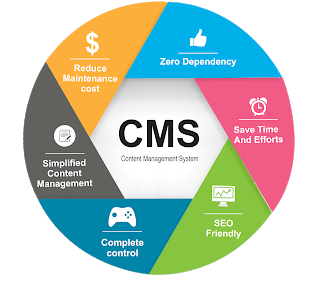A content management system, aka CMS, is a software designed to help people create, modify, and manage the content of a website without having to have technical knowledge about building a website.
Content management systems make it possible for people with little to no knowledge of coding to focus on the front end of a website by taking care of the backend. Some of the top CMS software are the following.
1. WordPress
Anyone reading this far through this article already knows or has at least heard of WordPress. This CMS has the maximum share in the market and has left its competitors behind by a considerable margin.
It was originally developed to be a blogging platform but has now grown far beyond that to become the most widely used CMS to ever be. It is liked by users because of the incredible level of flexibility that it provides. It has thousands of themes and plug-ins that anyone can use to make a website customized and personalized according to their specific needs.
WordPress is also known for its functionality like support for registrations and maintaining commenting and other interactions with the website users.
This CMS is popular for the following:
Efficient and effective content management and publishing options.
A powerful editor that formats the posts with ease.
High customizability with themes and plug-ins.
It is widely used and users can get help from a large community if they get stuck.
2. Joomla
Any debate about the best CMS cannot be complete without mentioning Joomla. As a general idea, Joomla is considered to be lesser beginner-friendly than WordPress, but it pays that off with greater flexibility and better functionality if you learn to use it.
One of the main selling points of Joomla is that it has multi-lingual support without the need for any plug-ins. It is also regarded to be a good option for making websites that have a lot of non-text content. People like Joomla because of these features:
It offers a lot of support for customized posts.
It includes enhanced user management tools.
It supports multiple languages without any plug-in.
Users can select separate templates for each page.
3. Drupal
Drupal is one of the most famous open-source CMS software. It is true that it is not as capable and as widely used as WordPress and Joomla but that doesn’t make it a lesser CMS than those.
Drupal has somewhat the same characteristics as Joomla including multi-lingual support out of the box and increased functionality. On top of that, it is known to be more secure than its competitors. People use Drupal because of the following features:
Its post creation and management systems are very flexible.
It has advanced management and permission settings for users.
It supports multiple languages out of the box.
It has an advanced taxonomy system.
It provides cutting edge security technology.
4. Typo3
Now, we’re going to discuss a lesser-known content management system. It doesn’t mean that it is not valuable. This CMS is just more specialized for some purposes and is not generally used. Typo3 is a CMS focused on scalability. It is used to develop enterprise-level websites. If you are tasked with developing an intranet, Typo3 will be the tool-of-choice for you. Typo3 is used by people because of the following features:
It is great to develop enterprise-level websites
Supports multiple languages
Offers the option to manage multiple websites from one installation
You can use it to share tools and data across your websites
Final Thoughts:
At the start, you needed to learn coding and a lot of other related things to be able to develop a website. The problem has now been solved by Content Management Systems. There are a lot of them available in the market. Some, like WordPress and Joomla, are intended for general websites, and others like Typo3 and Drupal are used for specific purposes.

